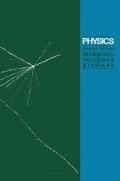Abstract
Virtually all the electric power produced in North America is obtained from a-c generators. The simplest of these was described in section 37.03. We saw in that section that a coil rotated in a uniform magnetic field generates an emf of form
where ω is the angular velocity of the coil. Practical generators do not have uniform fields. Instead, the rotating coil, or rotor, turns in the field of an electromagnet having several pairs of poles. The result is an emf of the form of (39.01), but ω is now equal to the angular velocity of the rotor times the number of pairs of poles. For this reason ω is renamed and called the angular frequency or the radian frequency. The renaming is also appropriate for emf’s with higher values of ω. These are produced by electronic oscillators which contain no (visibly) moving parts at all.
Preview
Unable to display preview. Download preview PDF.
Author information
Authors and Affiliations
Copyright information
© 1967 The Macmillan Company of Canada Limited
About this chapter
Cite this chapter
Marshall, J.S., Pounder, E.R., Stewart, R.W. (1967). Alternating Currents. In: Physics. Palgrave, London. https://doi.org/10.1007/978-1-349-81613-2_39
Download citation
DOI: https://doi.org/10.1007/978-1-349-81613-2_39
Publisher Name: Palgrave, London
Print ISBN: 978-1-349-81615-6
Online ISBN: 978-1-349-81613-2
eBook Packages: Palgrave Social & Cultural Studies CollectionSocial Sciences (R0)

